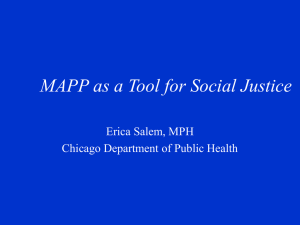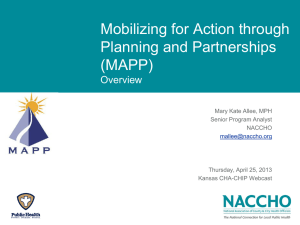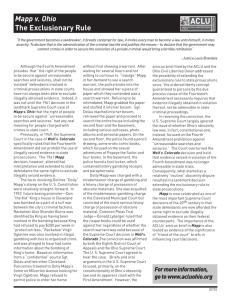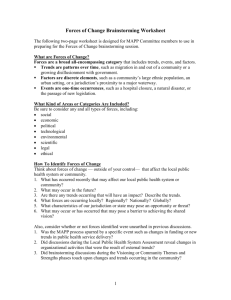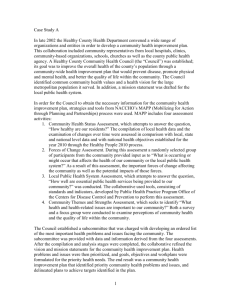Identify Strategic Issues At-A-Glance
advertisement
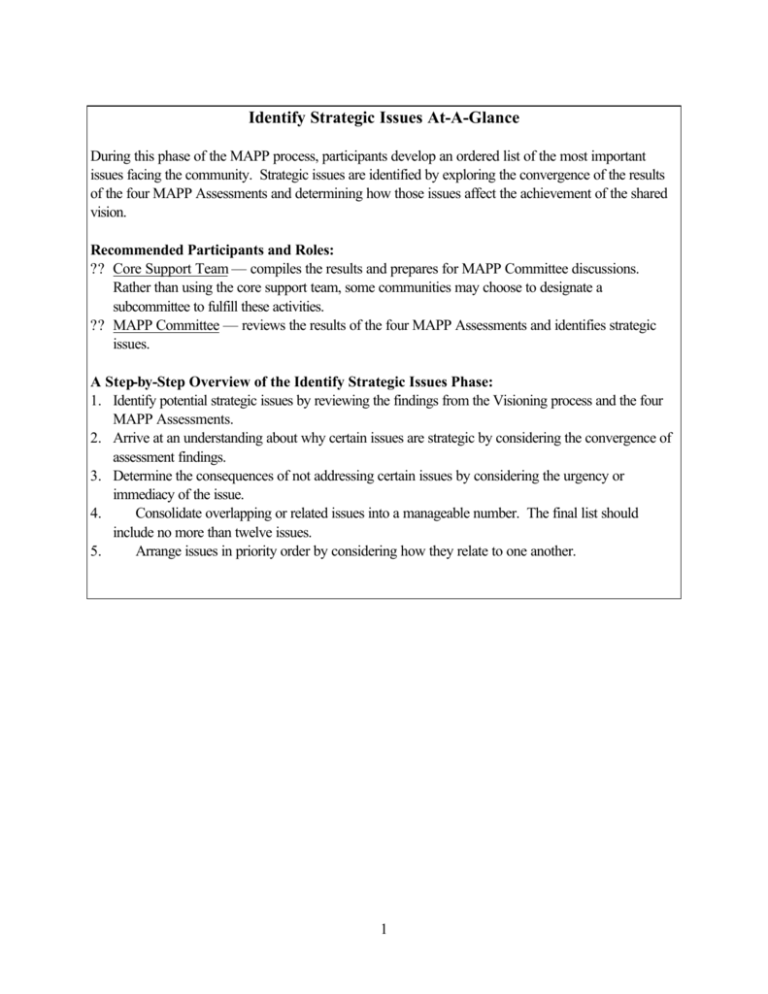
Identify Strategic Issues At-A-Glance During this phase of the MAPP process, participants develop an ordered list of the most important issues facing the community. Strategic issues are identified by exploring the convergence of the results of the four MAPP Assessments and determining how those issues affect the achievement of the shared vision. Recommended Participants and Roles: ?? Core Support Team — compiles the results and prepares for MAPP Committee discussions. Rather than using the core support team, some communities may choose to designate a subcommittee to fulfill these activities. ?? MAPP Committee — reviews the results of the four MAPP Assessments and identifies strategic issues. A Step-by-Step Overview of the Identify Strategic Issues Phase: 1. Identify potential strategic issues by reviewing the findings from the Visioning process and the four MAPP Assessments. 2. Arrive at an understanding about why certain issues are strategic by considering the convergence of assessment findings. 3. Determine the consequences of not addressing certain issues by considering the urgency or immediacy of the issue. 4. Consolidate overlapping or related issues into a manageable number. The final list should include no more than twelve issues. 5. Arrange issues in priority order by considering how they relate to one another. 1 Identify Strategic Issues Introduction to Identifying Strategic Issues Once the four MAPP Assessments have been completed, the next step is to use the findings to identify strategic issues. It is in this phase that participants determine which issues are critical to the success of the local public health system and its vision of improved community health. Strategic issues are those fundamental policy choices or critical challenges that must be addressed in order for a community to achieve its vision. Strategic issues are the foundation upon which strategies are developed. Strategic issues can be separated from “critical” issues by making the following distinctions: ?? Critical issues are important ?? Strategic issues are important and forward-thinking and seize on current opportunities When addressing “strategic” issues, a community is being proactive in positioning itself for the future, rather than simply reacting to problems. This is hard work but worth the effort. Strategic issues should build on the results of all of the previous MAPP phases. Up to this point, the planning process has largely focused on identifying the challenges and opportunities uncovered in the four MAPP Assessments. Strategic issues reveal what is truly important from the vast amount of information that has been gathered. Strategic issues emerge by examining the challenges and opportunities identified in the four MAPP Assessments and evaluating how they will affect the community’s achievement of the vision. Identifying strategic issues can be compared to pouring the assessment findings into a funnel — what emerges is a distilled mix of issues that demand attention. The graphic — Four MAPP Assessments Flowchart — shows how the identification of strategic issues can be seen as a funneling process. Another graphic — How Do the MAPP Components Relate? — illustrates how strategic issues form the link between using the information uncovered in the assessments (which form the foundation for planning) and achieving the vision. In addition to their critical importance to achieving a vision, strategic issues require either immediate or future action. This action will be guided by the strategies that result from the next stage of the process – Formulate Goals and Strategies. Strategic issues have several characteristics that separate them from findings identified earlier in the planning process. 1) They represent a fundamental choice to be made at the highest levels of the community 2 2) and local public health system. They focus on what will be done, who will be served, and by whom services will be provided. Strategic issues usually center around a tension or conflict to be resolved. Such tensions or conflicts may be related to differences between: past ways of doing things and future demands, current capacities and capacities necessary for delivering the Essential Services, the role of the local health agency and the roles of other community agencies, and the needs of the community and the resources available to meet those needs. 3) Strategic issues have no obvious best solution. If there is an obvious immediate solution to an issue, then question why it has not been implemented before. Such issues are likely to be operational concerns for individual organizational participants rather than strategic issues for the public health system. 4) A strategic issue must be something the local public health system can address. If an issue cannot be addressed by the local public health system, it may be strategic, but not at the community level. Issues such as universal health insurance coverage, poverty cessation, or eradicating a wide spread disease may be seen as strategic on a national level, however, few localities would have the means to take them on. How to Identify Strategic Issues Strategic issues can be identified by implementing the steps outlined below. With sufficient preparation, this process can generally be conducted over the course of one or two MAPP Committee meetings. Step 1 will generally take half of the allotted time; the subsequent steps can generally be conducted through group discussion during the remaining time. Active facilitation is useful in this stage. A skilled facilitator can keep the process moving along by identifying process steps, making suggestions about links between ideas, and ensuring that opposite viewpoints don’t negatively affect the process. See the Tip Sheet – Facilitation within the MAPP Process for helpful hints. The Chicago, IL vignette also offers insight into how this phase can be conducted. Step 1 — Identify potential strategic issues A variety of information has been generated through the previous phases, including: ?? a shared community vision and common values, ?? community themes and strengths, ?? forces of change — threats and opportunities, ?? local public health system challenges and opportunities, and ?? community health status issues. The vision often is a good starting point for identifying strategic issues. Here, it is important to ask, "What factors identified in the prior stages must be addressed in order to achieve the vision?" 3 Next, review findings from the four MAPP Assessments to get a good overview of the challenges and opportunities that are at work. In considering the findings from the MAPP Assessments and the Visioning process, some issues will appear obvious. Others will emerge after reviewing the information together and exploring areas where the findings converge. Further issues can be identified through scenario building. Create a scenario that links assessment findings in a story-like narrative and clarifies the impact of the findings. This will often highlight a specific issue that requires attention. Guard against the tendency to focus primarily on threats and weaknesses as opposed to opportunities, strengths, and assets. Capitalizing on these positive elements helps to assure there are resources that can drive strategies. The Strategic Issues Relationship Diagram is useful for seeing how the various findings converge to affect the achievement of the vision. (Also see the Strategic Issues Relationship Diagram Example for a completed worksheet.) There are a variety of ways to approach this step, depending upon the availability of meeting time and the willingness of participants to do individual work. These include: ?? having small groups prepare information prior to committee meetings, at which the committee members discuss and refine issues. ?? homework assignments in which all participants are asked to review the findings and come to meetings prepared with ideas about where strategic issues exist. ?? small group work, in which MAPP Committee members break into several groups and identify issues. The Core Support Team or a subcommittee can consolidate the results of the small groups. ?? a group process such as the one identified below: Record individual assessment findings in large type size on large post-it notes. Post large versions of the Strategic Issues Relationship Diagram worksheet on flip-chart paper on the walls. Then, move the assessment findings around, clump them together, and re-organize them as needed. If a finding relates to more than one potential strategic issue, use duplicates. As participants play with the findings and the diagram worksheets, potential strategic issues can be written in on the large diagrams. Group discussion should then occur to address the next steps – refining the issues and consolidating overlapping or related issues. By walking around the room and reading the information on the walls all participants can see the duplications and relationships at once. Once a strategic issue has been identified it should be phrased as a question on the first part of the Strategic Issues Identification Worksheet. Plan to develop a separate worksheet for each strategic issue identified. It is important at this point to focus on issues — not answers — to encourage a broad search for solutions in the next stage of the process. Strategic issues should provide clues to solutions and must be phrased so that less obvious solutions come to mind. Often the most obvious solution is 4 not the best, but represents a variation on a traditional approach to problem solving. This is especially important where participants have favored solutions. Step 2 – Develop an understanding about why an issue is strategic After strategic issues are identified, participants discuss each issue until they understand why it is strategic. This discussion will help to separate strategic issues from other problems. Participants must understand the context of issues to be able to make a wise decision about how to handle them. This understanding should provide insight into the dynamics of each issue. Each of the findings identified in the four MAPP Assessments point to one aspect affecting an issue. By considering findings from multiple assessments together, the understanding of the issue is likely to be more comprehensive. Findings from one assessment tend to expose only the surface aspects of a larger issue and may only lead to partial solutions. For example, if low immunization rates are considered alone as an issue, the response may be to increase public health agency immunization program efforts in the community. However, if findings such as diminished access to primary care, growth of managed care, and the feasibility of computerized immunization registries are considered, a broader issue emerges. Discuss each potential strategic issue, keeping in mind the definition and criteria for strategic issues. In addition, the following tests should be applied when considering a potential strategic issue. Strategic issues: ?? pose a threat, present an opportunity, or require a significant change. ?? require action on the part of public health system partners. ?? are frequently a convergence of narrow, single-focus issues. It is often the confluence of several seemingly insignificant issues that makes them strategic. The Strategic Issues Relationship Diagram is helpful for finding these. ?? involve conflict or tension between current and future capacities, actual and desired conditions, past performance and expectations, and old and new roles. ?? must be conditions about which participants can do something. ?? tend to be complex and will have more than one solution. ?? involve more than one organization. ?? generally project well into the future. Record information about each issue under question two of the Strategic Issues Identification Worksheet. The Chicago Partnership, described in the Chicago, IL vignette, illustrates how this works. 5 Strategic Issues Identification Example — Chicago, IL Vision: Accessible services How can the public health community ensure access to population based and personal health care services? was identified as a strategic issue by the Chicago Partnership after considering a key element of the vision statement and findings from each of the four assessment areas listed below. The vision called for access to a broad range of services and the findings all pointed to barriers that would have to be addressed to successfully reach that part of the vision. Community Health Status Assessment/Health Profile: ?? 52 percent of surveyed adults felt it was important to improve affordable health care in their community. ?? 7 percent use emergency rooms as regular source of medical care; 4 percent report having no regular source of care. ?? 15 percent have no insurance; only 27 percent of those insured have policies that cover wellness and health education. Community Forums: ?? Lack of insurance; confusion over CHIP program, ?? Language/cultural barriers and mistrust of system ?? Lack of pediatricians, no clinics for dental care, need more services for seniors; few programs/services for men ?? Lack of day care, inconvenient hours, long clinic waits Forces/Trends: ?? Inadequate insurance coverage; employer-based model not working ?? Confusion over CHIP guidelines; rigid application process. ?? Disparities are exacerbated by access challenges and racism Local Public Health System Assessment: ?? 42 of 60 survey respondents report linking people to health services; assuring the provision of care when otherwise not available. ?? Many agencies conduct outreach, often for different purposes and high-need populations. Step 3 — Determine the consequences of not addressing an issue Strategic issues have significant consequences for the community or the public health system. Failure to address these issues eventually results in the realization of an external threat, a lost opportunity, the lingering or worsening of an identified problem, and ultimately a failure to achieve the community vision. 6 Consider each strategic issue and ask, “what are the consequences of not addressing this?” Each strategic issue will generally fall into of the following three categories: 1. No action is currently required, but the issue should be monitored for future action (e.g., population, immigration, demographic shifts, or growth of managed care). 2. Action can be determined through the strategic planning process. (Most issues will fall into this category.) 3. The issue appears urgent and requires an immediate response (e.g., legislation that is being considered). The consequences of each strategic issue should be specified in part three of the Strategic Issues Identification Worksheet. Step 4 — Consolidate overlapping or related issues At this point, a large number of strategic issues may have been identified. To provide a manageable focus for developing strategies, strategic issues should be consolidated to a limited number of discrete non-overlapping issues. Ideally, a community should have no more than twelve strategic issues; the fewer, the better. To do this, examine all the issues identified from the worksheets together. How are they related? Do they share causes or influences that make them strategic? What are the consequences of not addressing them? Can strategic issues be combined without losing a key perspective? Step 5 — Arrange issues into an ordered list Ordering strategic issues can help reveal how they relate to each other and may be useful for developing strategies. Strategic issues can be ordered in three ways: 1. Logical order — Present issues in the sequence in which they should be addressed. This is useful where the resolution of one issue is contingent on resolution of another. 2. Impact order — How strategic is an issue? How important are its consequences? How complex is an issue? Resolving easier issues first can build the momentum, teamwork, and consensus that can lead to solutions for more complex, controversial issues. 3. Temporal order — Resolve issues according to a timeline, using information such as coordination with upcoming events or a logical order for dealing with the issues. For example, an issue that seems to require a policy strategy may be timed to coincide with the state legislative cycle. Clarifying the meaning of “priority” may prevent resistance from participants who don’t find the issues they feel strongly about at the top of the list. While priority suggests importance, it can also mean order; 7 it is this definition that should be stressed. 8 Identification of Strategic Issues Chicago, IL Vignette At its October 1999 meeting, the Chicago Partnership identified the strategic issues that would need to be addressed if its vision for public health in Chicago was to be achieved. The process began with a review of five 1-2 page "key findings" documents that staff had prepared to remind members of the major points that had emerged from the partnership's prior work in the following five areas: • • • • • Vision for Chicago's public health system Health Profile Community Forums Analysis of Trends and Forces Public Health System Assessment Members were asked to consider the findings both individually and collectively in an effort to identify predominant and cross-cutting issues. Staff then distributed a preliminary list of six possible strategic issues for the partnership to consider as a starting point for the discussion. Each of the preliminary issues was reviewed in turn and discussion centered on how each reflected the partnership's vision and captured the findings of its four analyses. Some members suggested that new wording be used to better reflect the scope of the partnership's thinking. The senior project staff, serving as facilitator, challenged participants who suggested major changes, including new strategic issues, to link them to the vision and findings of the analyses. By the end of the two-hour meeting, six strategic issues had been identified by the partnership. These included: ?? How can governmental public health agencies demonstrate more effective leadership in areas of policy development, assessment and assurance? ?? How can the Partnership strengthen coordination among public health partners in order to assure the health of the public? ?? How can Chicago's public health community and its partners eliminate racial/ethnic, gender and social class disparities in health status? ?? How can the public health community ensure access to population based and personal health care services? ?? How can the Partnership foster the development of sustainable community-based partnerships to increase the community's voice in system's planning, program development, policy and advocacy? ?? How can the public health community most effectively (a) foster the sharing of data and other information between agencies, (b) array its vast information resources in the most useful manner, and (c) disseminate information to the public and other users? 9
